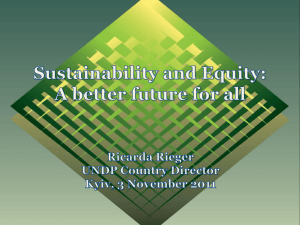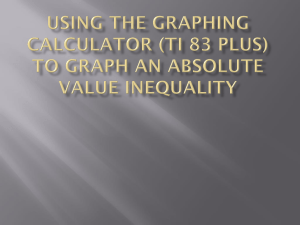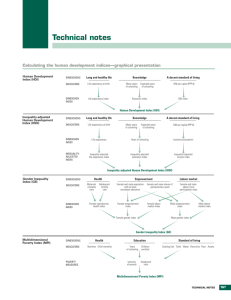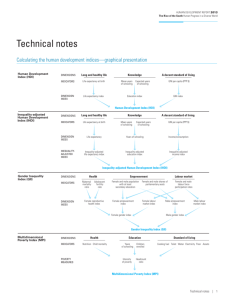HDI and inequality - Human Development Reports
advertisement
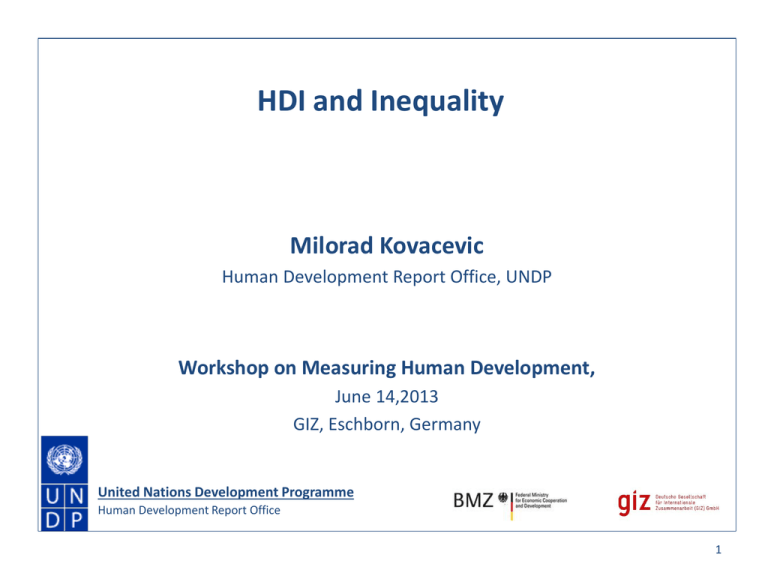
HDI and Inequality Milorad Kovacevic Human Development Report Office, UNDP Workshop on Measuring Human Development, June 14,2013 GIZ, Eschborn, Germany United Nations Development Programme Human Development Report Office 1 Inequality and Human Development • Equality is at the core of the human development approach which intrinsically pursues the value of social justice • The country-average HDI conceals wide disparities in distribution of HD across population within a country • False impression: Every one within the country has the same HDI Equal distribution of HD within the country • Two countries with different distributions of achievements can have the same average HDI HDRO 2 Inequality in dimensions of HDI • A statistical measure that characterizes the dispersion in the distribution of some attribute – the second moment of the distribution… or • …a summary measure of the “loss in the social objective as compared to the potential degree of achievement, with loss being] interpreted as the loss that can be attributed to inequalities.” • Inequality in concentration of income and other forms of material wealth • Inequality in distribution of other characteristics (e.g., years of education) is often recognized, but rarely measured and always questioned. HDRO 3 Inequality in dimensions of HDI How to interpret inequality in health? • Would societies be willing to shorten some people’s lives or lower their educational achievements to lower health or education inequality? Or • Should societies accept the fact that some people die young--some even before their 5th birthday? The idea is not to shorten lives but to increase for those with low levels of survival --through policies? HDRO 4 Distributions of HDI dimensions Disposable Income, simulated HDRO Distribution of years of schooling Example: India, Source: DHS 2005/06 5 Distribution of (expected) length of life, from life tables India 2005-2010 Age-group w 0 0.01344 1 0.00357 5 0.00548 …. 25 0.0229 …. 50 0.02861 55 0.03875 60 0.06059 65 0.08825 …. 95 0.03692 100 0.05533 HDRO my 0.0997024 2.605042 7.50365 27.49956 52.49948 57.50064 62.49975 67.5004 96.50081 103.9714 Afghanistan Bangladesh Bhutan India Iran Maldives Nepal Pakistan Sri Lanka Life Atkinson expectancy measure( ε=1) 49.1 0.509 69.2 0.232 67.6 0.241 65.8 0.271 73.2 0.161 77.1 0.073 69.1 0.195 65.7 0.323 75.1 0.094 6 Inequality-adjusted Dimensional Indices • Distributional data at the level of household or individual • Variables relevant to three dimension: Household consumption or income per capita Years of schooling Expected length of life • Source of data: Nationally representative household surveys UN life tables HDRO 7 Inequality-adjusted Dimensional Indices • From distributional data (𝑥1 , … , 𝑥𝑛 ) Atkinson measure of inequality 𝐴 𝜀 ; 𝜀 = 1 𝐴𝑥 1 = 1 − 𝑥𝑖 𝑤𝑖 𝑔𝑒𝑜𝑚 =1− 𝑤𝑖 𝑥𝑖 𝑎𝑟𝑖𝑡ℎ • Accounts for inequality of distribution of achievements in the HDI dimension across population • From dimensional index 𝐼𝑥 and distributional data Inequalityadjusted (dimensional) index 𝐼 ∗ 𝑥 = (1 − 𝐴𝑥 )𝐼𝑥 • Sen’s welfare function. Discounts the average value by the level of inequality in the dimension HDRO 8 Inequality-adjusted HDI 𝐼𝐻𝐷𝐼 = = 𝐻𝐷𝐼 ∙ 3 3 𝐼 ∗ 𝐿𝐸 ∙ 𝐼 ∗ 𝑒𝑑𝑢 𝐼 ∗ 𝑖𝑛𝑐 (1 − 𝐴𝐿𝐸 ) ∙ (1 − 𝐴𝐿𝐸 ) ∙ (1 − 𝐴𝐿𝐸 ) Important properties (questionable because of the use of Life tables): • Sub-group consistency • Path Independence • Distribution sensitive (higher weight at the lower and of distribution) Foster, Lopez, Szekely (2004) HDRO 9 Interpretation of the IHDI • HDI is the average level of Human Development • IHDI is distribution sensitive average level of HD • IHDI is equal to HDI if there is no inequality • The loss in the HDI due to inequality experienced by an average person is 𝑰𝑯𝑫𝑰 𝟑 𝟏− = 𝟏 − (𝟏 − 𝑨𝑳𝑬 ) ∙ (𝟏 − 𝑨𝑬𝑫𝑼 ) ∙ (𝟏 − 𝑨𝑰𝑵𝑪 ) 𝑯𝑫𝑰 HDRO 10 Interpretation of the IHDI (contd.) Problematic? • HDI is the potential level of HD that can be achieved if everyone is equal • IHDI is the actual level of HD when inequality is accounted for • Use of Atkinson’s logic for inequality in economic welfare 𝑦𝐸𝐷𝐸 𝜀 𝐼 𝜀 =1− 𝜇 𝑦𝐸𝐷𝐸 𝜀 is the level of income per person that, if equally distributed, would yield the same level of welfare. • Is it right to say: The IHDI is the average human development achievement that if equally distributed would yield the same level of HD as estimated by the HDI. 11 Additional Concerns • Income index (log transformed) is adjusted by inequality from untransformed income data • Atkinson index cannot be calculated when zero values are present; an arbitrary solution • Choice of ε in the Atkinson index: - Aversion to inequality, ε, can be both - dimension and country specific: 150 countries x 3 dimensions = 450 ε. 12 Recommendation • To avoid a misinterpretation (or a lack of a good interpretation): - Estimate inequality in distribution of human development across population as a stand-alone measure - a mean of inequalities in the distributions of the three dimensions across the population: - 𝟏 − 𝟑 (𝟏 − 𝑨𝑳𝑬 ) ∙ (𝟏 − 𝑨𝑬𝑫𝑼 ) ∙ (𝟏 − 𝑨𝑰𝑵𝑪 ) , or - (𝑨𝑳𝑬 +𝑨𝑬𝑫𝑼 + 𝑨𝑰𝑵𝑪 )/𝟑 • Is there advantage of using the geometric mean? • Computational concerns remain 13 Thanks Milorad.Kovacevic@undp.org 14





